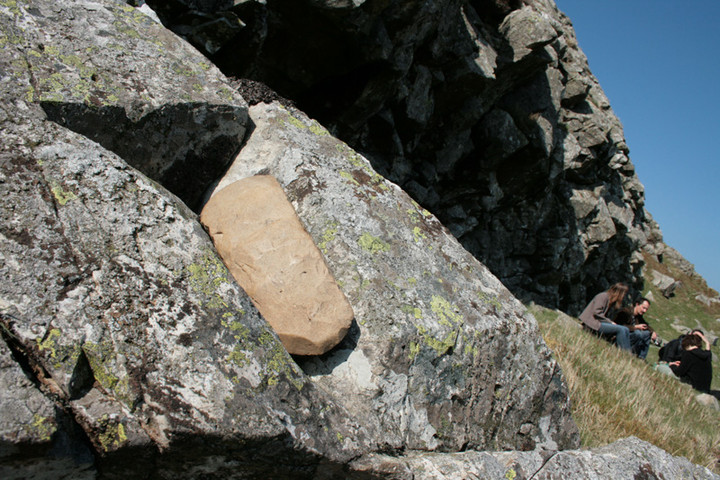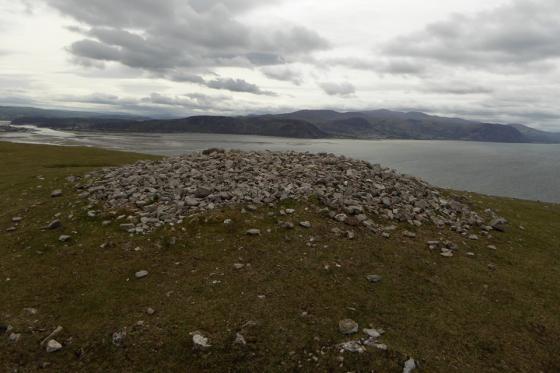
Towards the site of the ‘axe factory’... and destroyed hill fort... from Tal-y-Fan

Towards the site of the ‘axe factory’... and destroyed hill fort... from Tal-y-Fan

Sunburst, looking from Tal y Fan....

Graig Lwyd (far right) in its setting between sea and mountains. The Druid’s Circle and monument complex is in the hills towards the centre. Seen from Trwyn Du at the northeast tip of Anglesey.


Toward the modern workings from an ancient settlement.... unfortunately, according to Coflein, of Roman origin.

Just below and to the north-west of The Druid’s Circle.

Not the most inspiring of landscapes nowadays...

A God forsaken and blasted hillside, this was once the site of a Neolithic Axe production site. (see how I avoided the word factory.)

Graig Lwyd from path below Foel Lus.

Graig Lwyd axe factory. Spring 2009.
Thin butted Danish part polished Danien flint working axe nestled amongst the rock.
Enjoy
Blingo

Came across this view from Llwytmor, looking across the Anafon valley. The site is top right of image. Incidently the centre ridge line leads to the burial cairns upon Carnedd y Ddelw, Drum, Foel Grach and, eventually, Carnedd Llewleyn itself.

Highlighting the fine, coastal location of the site [top right], looking across Llyn Anafon from Foel Fras, Y Carneddau.

I found this in the river near Aber falls 4 miles from Graig Lwyd ,Is it an axe

Taken 17th January 2004: From a selection of axe maker’s tools, these are scrapers found at Graig Lwyd, now exhibited at the National Museum and Galleries of Wales in Cardiff.
North Walian travellers looking for a ‘ritualistic quarrying vibe’ similar to that seemingly prevalent upon the utterly wondrous Langdale Fell should perhaps look elsewhere.... albeit (arguably) in vain. Sadly the ravaged headland of Graig Lwyd isn’t going to soothe a ragged psyche in need of sedation. Quite the reverse. In fact I’d wager a shiny brass farthing that any TMA’er standing upon this coastal summit will experience thoughts of sedition against a society that cares so little about our ancient heritage. Can we be blamed for the security of ignorance, as Dave Gahan once crooned?
Yeah, the outlook from the top to the coast is not a pretty sight, looking out across Conwy Bay toward the lowlands of Anglesey. This negative perception is nothing to do with the enigmatic Ynys Mona of course; but rather the inevitable result of devastation wrought by modern man’s insatiable desire to rape the landscape regardless of cost. The thought arises... oh dear... ‘but hold on though, were not our prehistoric forebears doing very much the same here, albeit on a (presumably) much reduced scale?’ Does the fact that they quarried stone from this very hillside to fashion exquisite stone implements make their actions any more worthy? Hmm. Guess it rather depends upon how the individual views the importance of scale of operations, amongst other things. Is a red kite ‘better’ than a crow just because there are less of them? Is it moral that familiarity breeds contempt? My ignorance duly exposed, I defer such ponderings for another day when I’ve some evidence to deliberate. Perhaps there is an axe to grind here, perhaps not? But, as of old, that is probably best done down below.
The summit of Graig Lwyd is girdled by pretty substantial drystone walling. However, upon clambering up from the exquisite Cefn Coch cairn to the south, I find a gate which allows access. Whether the landowner has issues with the odd (or not so odd, depending on your point of view) person having a look to see if they can make out the cairn and settlement depicted on the map I’m afraid I can’t say... since he sped by on a quad bike before I could ask the question. For the record I located the settlement (quite substantial but apparently Roman, at least according to Coflein), but not the cairn. Nevertheless I’m happy that I can declare, in the immortal words of Max Boyce, that ‘I was there’ to witness the extraordinary continuity of human industry. One also wonders why Romans / Romano-British saw fit to seek accommodation here? Quarrymen, or attracted by that ‘ritualistic quarrying vibe’?
Curiosity sated, I turn toward the much more aesthetically pleasing southern aspect and note what appears to be a fine arc of kerbing below at Cors y Carneddau. Worth a look? You betcha.
A brief description of the axe factory and the surrounding area


























































































































































